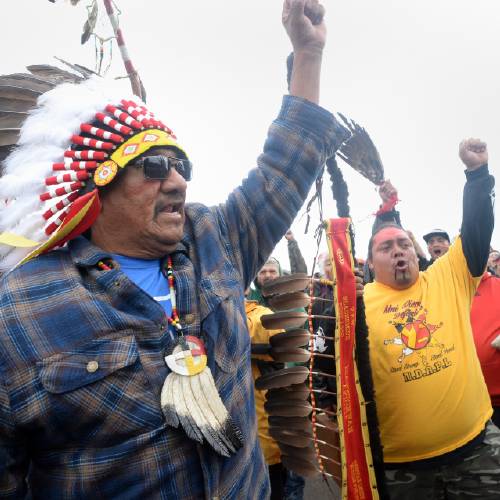-
Tips for becoming a good boxer - November 6, 2020
-
7 expert tips for making your hens night a memorable one - November 6, 2020
-
5 reasons to host your Christmas party on a cruise boat - November 6, 2020
-
What to do when you’re charged with a crime - November 6, 2020
-
Should you get one or multiple dogs? Here’s all you need to know - November 3, 2020
-
A Guide: How to Build Your Very Own Magic Mirror - February 14, 2019
-
Our Top Inspirational Baseball Stars - November 24, 2018
-
Five Tech Tools That Will Help You Turn Your Blog into a Business - November 24, 2018
-
How to Indulge on Vacation without Expanding Your Waist - November 9, 2018
-
5 Strategies for Businesses to Appeal to Today’s Increasingly Mobile-Crazed Customers - November 9, 2018
Feds halt work on part of oil pipeline despite court ruling
Members of the Standing Rock Sioux Tribe met outside the steps of the Washington, D.C., courthouse August 25 to protest the construction of the pipeline, which they say would wreak havoc on their native lands and cause widespread water contamination.
Advertisement
The Standing Rock Sioux’s tribal historian says a federal judge’s decision to deny a request for a temporary stop of construction on the Dakota Access pipeline gives her “a great amount of grief”. Immediately after the ruling, the federal agencies announced a halt to work in one area significant to the tribe.
The pipeline was to run just north of the Standing Rock Sioux reservation.
The ruling is a devastating moment for Native American rights activists as well as environmental rights activists.
The Standing Roc Sioux argued the U.S. Army Corps of Engineers did not do enough to consult with tribal members.
The Army Corps of Engineers has declined to comment, citing the pending litigation.
A joint statement from the Army and the Departments of Justice and the Interior said construction bordering or under Lake Oahe would not go forward and asked the Texas-based pipeline builder, Energy Transfer Partners, to stop work 20 miles to the east and west of the lake while the government reconsiders “any of its previous decisions”.
“Native peoples have suffered generations of broken promises and today the federal government said that national reform is needed to better ensure that tribes have a voice on infrastructure projects like this pipeline”.
Dakota Access will take North Dakota oil across eastern South Dakota, right by Sioux Falls, through Iowa to IL.
Hundreds gathered in cities as far away as Denver and Tulsa to protest the fast-track approval given to Energy Transfer Partners and their subsidiary Dakota Access, LLC.
“Officials with pipeline company Energy Transfer Partners didn’t return The Associated Press’ phone calls or emails seeking comment”.
The pipeline’s original route crossed the Missouri River near Bismarck, N.D., The New Yorker reported, “but authorities anxious that an oil spill there would have wrecked the state capital’s drinking water. So they moved the crossing to half a mile from the reservation, across land that was taken from the tribe in 1958, without their consent”.
“Our tribe is going to appeal”, said Dave Archambault II, chairman of the Standing Rock Sioux Tribe. The Yankton Sioux tribe in South Dakota did the same yesterday.
Contrary to the tribe’s assertions that it was left out of the process, Boasberg said, the corps has documented dozens of its attempts to engage with Standing Rock officials in consultations to identify historical resources at Lake Oahe and other places covered by the permit. Now, the oil company will be allowed to continue building the pipeline according to schedule, which is set to be finished before the end of the year. It adds that the Dakota Access “will be built and operated using the most advanced technology and monitoring systems to make it even safer”.
The lawsuit from the South Dakota tribe was filed Thursday and is separate from the one filed by the Standing Rock Sioux on which a federal judge is expected to rule Friday.
Attorney Jan Hasselman with environmental group Earthjustice, who filed the lawsuit in July on behalf of the tribe, said in the days before the ruling that it’ll be challenged. Tribal leaders say the project violates several federal laws and will harm water supplies.
A status conference in the Standing Rock Sioux’s lawsuit is scheduled for September 16. Aware of the indignities visited upon the Tribe over the last centuries, the Court scrutinizes the permitting process here with particular care.
The tribe says it will appeal.
Cramer says the Army Corps of Engineers did follow proper protocol, pointing out that the route of the pipeline changed several time after other tribes raised concerns.
The judge’s order was announced over a loudspeaker at the protest camp near the reservation on North Dakota’s southern border.
Thousands of protesters have gathered at the camp, representing as many as 200 tribes from across North America.
On the same day has the court ruling, protesters got help from an unexpected quarter.
The tribe says the pipeline threatens sacred sites and drinking water.
Tensions dramatically escalated over the weekend, resulting in violence. Several hundred protesters marched about a mile up Hwy 1806, Friday Sept. 9, 2016, from the protest camp to the area of the pipeline site where some archeological artifacts have been discovered.
Advertisement
A federal judge is set to deliver a key ruling on the four-state Dakota Access pipeline that has drawn thousands of protesters to a construction site in North Dakota in recent weeks. “We call upon all water protectors to greet any decision with peace and order”, he said in a statement on the tribe’s Facebook page.





























